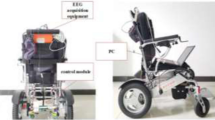Abstract
The aim of the present study was to propose an effective and low-delayed asynchronous SSVEPs-based BCI system for practical wheelchair control. The paradigm was based on the discrimination of Steady-state visually evoked potential (SSVEP) which is widely applied to various audiences. Bayesian Classifier and a low-delayed asynchronous detection mechanism were devised and integrated to enable the user to control the wheelchair flexibly. In particular, comparing with the traditional method using a fix threshold or a simple classification model to distinguish idle state and task state, our detection mechanism exhibited higher accuracy and possessed a better performance for wheelchair. Five subjects took part in our offline task and two of them continued the on-line task on a real wheelchair. In average, we achieved a classification accuracy of 87.17% in task state and 92.70% in idle state and two subjects accomplished on-line task using 187 s and 298 s, respectively.
Access this chapter
Tax calculation will be finalised at checkout
Purchases are for personal use only
Preview
Unable to display preview. Download preview PDF.
Similar content being viewed by others
References
Birbaumer, N., Ghanayim, N., Hinterberger, T., Iversen, I., Kotchoubey, B., Kübler, A., Perelmouter, J., Taub, E., Flor, H.: A spelling device for the paralyzed. Nature 398, 297–298 (1999)
Wolpaw, J.R., Birbaumer, N., McFarland, D.J., Pfurtscheller, G., Vaughan, T.M.: Brain-computer interfaces for communication and control. Clin. Neurophysiol. 113, 767–791 (2002)
Vidal, J.J.: Toward direct brain–computer communication Annu. Rev. Biophys. Bioeng. 2, 157–180 (1973)
Middendorf, M., et al.: Brain–computer interfaces based on the steady-state visual-evoked response. IEEE Trans. Rehabil. Eng. 8, 211–214 (2000)
Morgan, S.T., Hansen, J.C., Hillyard, S.A.: Selective attention to stimulus location modulates the steady-state visual evoked potential. Proc. Natl. Acad. Sci. U. S. A. 93, 4770–4774 (1996)
Friman, O., Volosyak, I., Graser, A.: Multiple channel detection of steady-state visual evoked potentials for brain–computer interfaces. IEEE Trans. Biomed. Eng. 54, 742–750 (2007)
Allison, B., Lüth, T., Valbuena, D., Teymourian, A., Volosyak, I., Gräser, A.: BCI demographics: How many (and what kinds of) people can use an SSVEP BCI? IEEE Trans. Neural Syst. Rehabil. Eng. 18(2), 107–116 (2009)
Parini, S., Maggi, L., Turconi, A.C., Andreon, G.: A robust and self-paced BCI system based on a four class SSVEP paradigm: algorithms and protocols for a high-transfer-rate direct brain communication. Computational Intelligence and Neuroscience, 1–11 (2009)
Mason, S.G., Birch, G.E.: A brain-controlled switch for asynchronous control applications. IEEE Trans. Biomed. Eng. 47, 1297–1307 (2000)
Bin, G., Gao, X., Yan, Z., Hong, B., Gao, S.: An online multi-channel SSVEP-based brain-computer interface using a canonical correlation analysis method. Journal of Neural Engineering 6, 1–6 (2009)
Beverina, F., Palmas, G., Silvoni, S., Piccione, F., Giove, S.: User adaptive BCIs: SSVEP and P300 based interfaces. Psychology 1(4), 331–354 (2003)
Muller-Putz, G.R., Pfurtscheller, G.: Control of an electrical prosthesis with an SSVEP-based BCI. IEEE Trans. Biomed. 55, 361–364 (2008)
Ortner, R., Allison, B., Korisek, G., Gaggl, H., Pfurtscheller, G.: An SSVEP BCI to control a hand orthosis for persons with tetraplegia. IEEE Trans. Neu. Syst. Rehabil. Eng. (2010)
Diez, P.F., Mut, V.A., Perona, E., Leber, E.L.: Asynchronous BCI control using high-frequency SSVEP. Journal of Neural Engineering 8, 1–8 (2011)
Hotelling, H.: Relations between two sets of variates. Biometrika 28, 321–377 (1936)
Lin, Z.L., Zhang, C.S., Wu, W., Gao, X.R.: Frequency recognition based on canonical correlation analysis for SSVEP-based BCIs. IEEE Trans. Biomed. 53, 2610–2614 (2006)
Author information
Authors and Affiliations
Editor information
Editors and Affiliations
Rights and permissions
Copyright information
© 2012 Springer-Verlag Berlin Heidelberg
About this paper
Cite this paper
Xu, Z., Li, J., Gu, R., Xia, B. (2012). Steady-State Visually Evoked Potential (SSVEP)-Based Brain-Computer Interface (BCI): A Low-Delayed Asynchronous Wheelchair Control System. In: Huang, T., Zeng, Z., Li, C., Leung, C.S. (eds) Neural Information Processing. ICONIP 2012. Lecture Notes in Computer Science, vol 7663. Springer, Berlin, Heidelberg. https://doi.org/10.1007/978-3-642-34475-6_37
Download citation
DOI: https://doi.org/10.1007/978-3-642-34475-6_37
Publisher Name: Springer, Berlin, Heidelberg
Print ISBN: 978-3-642-34474-9
Online ISBN: 978-3-642-34475-6
eBook Packages: Computer ScienceComputer Science (R0)




